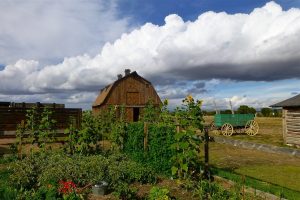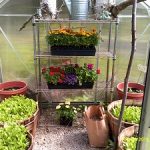5 Helpful Tips on How to Get the Most Food from Your Survival Garden
5 Helpful Tips on How to Get the Most Food from Your Survival Garden
 The amount of produce you can expect from your survival garden depends on your farming techniques as wl as your practices. Your physical strength is good enough but you may also have to deal with your mindset to lower the time and effort you put so that you can do more. Crop failure is something that stalks survival gardeners like their shadow especially if they are new to it.
The amount of produce you can expect from your survival garden depends on your farming techniques as wl as your practices. Your physical strength is good enough but you may also have to deal with your mindset to lower the time and effort you put so that you can do more. Crop failure is something that stalks survival gardeners like their shadow especially if they are new to it.
However, having the right information and making the best decisions are the major ingredients for success in your survival garden. Our aim here is to educate you on how to get the most food from your survival garden. Here are some tips on how to expand your food production in the times of crisis when conventional food production is low or has ceased.
- Choose Right Plants
 During a crisis, it would be counterproductive to go for your favorite plants. This is not the time to experiment with foreign plants that you are not sure of their growth characteristics and yield. Instead, you should go for local and regional plants that are adapted to the climatic conditions in your area. Such plants will not require very special conditions to grow successfully.
During a crisis, it would be counterproductive to go for your favorite plants. This is not the time to experiment with foreign plants that you are not sure of their growth characteristics and yield. Instead, you should go for local and regional plants that are adapted to the climatic conditions in your area. Such plants will not require very special conditions to grow successfully.
At times it may be difficult to find even the local plants for survival gardens or the ones that are available locally are not ideal for your type of soil. In that case, you can research on the plants that can do well across multiple United States Department of Agriculture (USDA) growing zones. The good news is that most common garden fruits and vegetables we love grow successfully in these zones.
In the list of foods that grow in USDA zones, you will find a variety of crops that can do well locally. However, not all of them can grow well during a crisis as they require spraying and irrigating. To get the most food from your survival garden, you must choose only those plants suited for dryland farming. You also need to choose plants that are resistant to pests and diseases.
The particular plant you choose for your survival garden is another important consideration. For instance, plants such beans or peas have lower production potential when it comes to survival. 20 individual tomato plants of the indeterminate variety can produce a lot of fruits to last you several months, even years. You cannot say the same of 20 plants of beans which may provide on two or three meals depending on the size of your family.
- Location and Access to the Survival Garden
 What would influence your decision to buy a property such as real estate or to start a business? I would say location is the single most important determinant of your decision. The same applies if you must get the most food from your survival garden. The closer you situate your garden to your home, the more attention you will give them and the less time you will require tending to them.
What would influence your decision to buy a property such as real estate or to start a business? I would say location is the single most important determinant of your decision. The same applies if you must get the most food from your survival garden. The closer you situate your garden to your home, the more attention you will give them and the less time you will require tending to them.
During the crisis, crossing vast open grounds to go weed, water, prune and harvest your survival garden situated far from your house may not be feasible. However, you need to be wise in locating your survival garden or gardens. Situate those plants that need close attention and frequent harvesting close to the paths you already take and near the resources they will need to grow perfectly such as water source.
For instance, rotational survival garden plants that require a lot of watering and get harvested frequently must be as close to the house as possible to minimize the effort and time you use in tending to them and thereby boosting their production. Those plants that are susceptible to growth problems will also do well if you grow them in proximity to your house.
Remember survival garden water source is your rooftop. Collecting rainwater in a reservoir and using it to water your plants will not only boost food production but also save you a lot when it comes to the water bill. It would be helpful to locate your garden close as close to the house as possible. You can even place beds near your outdoor water faucets or doorways.
- Be Unique and Consult Widely
At the time of crisis, what you know best is what will help you out. In order to gain much food from your survival garden, you must be unique in the plants you grow. An all too common saying is that a neighbor’s compound is always greener (than yours). This might be the case but you do not know what your neighbor did to have such high-quality garden and any attempts to replicate it can lead to serious crop failure – something you do not want for your survival garden.
The furthest you can do is to take advice from them to learn their secret. This is especially important if you are new to prepping. You need to keep in mind that each family is different in their nutritional requirements and their preferences. The same applies to your home and therefore you must make your decision in consideration of family preferences.
Sometimes, expert opinion is necessary. Experts can provide you with information regarding the best plants that can do well in extreme condition and in your area. They can also tell you which particular seeds are perfect for survival gardens. Such experts include horticulturalists as well as experienced doomsday preppers.
- Allow Room for Renovation
It is impossible to know for sure which day will prove to be doomsday. Therefore, you should leave room for renovation to boost production as time progresses. You can also start your survival garden with temporary structure so that you can add more permanent structure when you have gained enough experience to manage your garden well.
If you are new to survival gardening, you need to start with lasagna beds, container gardens or flour and ornamental beds for vegetables and fruits. With time, you will replace them for unbounded, open-from beds as you gain survival garden maintenance experience. Such free-form beds will require some form of barrier to save your plants from rodents and pests.
- Adopt the Best Garden Management Practices
How you manage your survival garden will directly influence its productivity. This has a lot to do with your gardening skills and even your mentality. Choosing the best site for the garden as well as selecting the particular plants to grow is of crucial importance. In addition, you must know the nutritional requirement of each plant as well watering needs.
Pest and disease control methods are of utmost importance if you are to get the most food from your survival garden. Initially, ensure you choose plants that are resistant to common pests and diseases in home gardens. However, that does not mean your garden will not face such problems. Therefore you must be ready to naturally control any pests and diseases that might interfere with their yields. When it comes to soil fertility, you will need to use organic fertilizer and not commercial versions.
Final Verdict
Only good preppers will weather the storm when it finally comes. At the center of successful survival is a food source. When it is difficult to buy food from the grocery stores, you can guarantee the successful survival of your loved ones by providing them with a reliable food source. The best source of food would be a survival garden. At least you now know how to get the most food from your survival garden. Use the information herein and you will be surprised how productive your little survival garden will be.
Related Articles HERE!
5 Helpful Tips on How to Get the Most Food from Your Survival Garden Food garden survival Survival Garden tips


One Response
How about editable invasive plants, such as mints, basils, and mulberry trees? They don’t need much care and can grow and reproduce on their own.